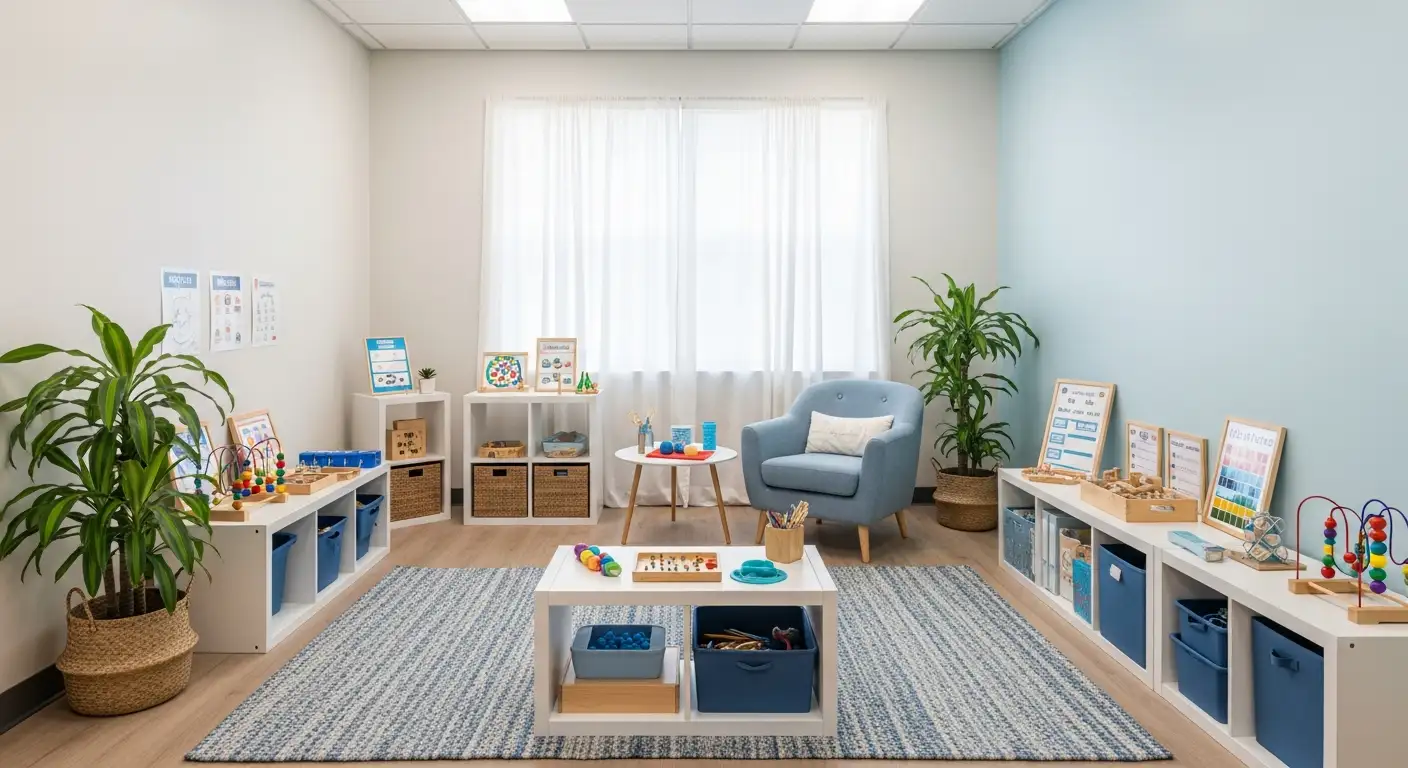Understanding How In-Home ABA Therapy Cultivates a Natural Learning Setting
In-home ABA therapy has revolutionized how children with autism develop essential skills by integrating intervention strategies into familiar, everyday environments. This approach not only makes therapy more comfortable and engaging but also significantly enhances skill generalization, fostering independence and social participation. By focusing on natural routines and involving families in the process, in-home ABA therapy creates a seamless bridge between learning and daily life, supporting the child's holistic development.
The Fundamentals of In-Home ABA Therapy and Its Role in Natural Learning

How does in-home ABA therapy promote a natural learning environment for children with autism?
In-home ABA therapy creates an environment that feels familiar and safe for children, which is essential for effective learning. Because therapy takes place in the comfort of the child’s own home, children tend to be more relaxed and focused. This setting minimizes anxiety and sensory overload, common challenges in unfamiliar or clinical environments.
The personalized nature of in-home therapy allows therapists to seamlessly incorporate learning into daily routines like mealtime, play, and bedtime. These real-life activities are fundamental opportunities for skill development, such as communication, social interactions, and independence. Since these are naturally occurring parts of the child's day, the skills learned are more relevant and easier to generalize to other settings.
Family involvement is vital in this process. When parents and siblings participate, they reinforce learning and create consistency across situations. This ongoing support ensures that children can transfer skills learned during therapy sessions into their everyday life outside of formal therapy time.
Furthermore, the home environment offers access to familiar objects and resources that support functional skill-building, such as using household items for teaching or practicing daily tasks. This contextual learning helps children understand and apply new skills in meaningful ways.
Overall, in-home ABA therapy promotes a genuine, natural learning experience by contextualizing skill development within the child's true environment. This helps children gain confidence, encourages independence, and makes learning an integral part of their daily routines, ultimately supporting comprehensive growth beyond therapy sessions.
The Power of Natural Environment Teaching (NET) in ABA Therapy

What is Natural Environment Teaching (NET) and what are its core principles?
Natural Environment Teaching (NET) is an approach used in ABA therapy that emphasizes teaching skills within the child’s everyday environments. Unlike traditional, highly structured methods, NET integrates learning into natural routines and settings such as home, park, or during play.
Its core principles include observing the child's interests, utilizing incidental teaching techniques, and aligning activities with the child's motivations. TEACHING is often embedded into fun, familiar activities that the child already engages in, making learning more relevant and less intimidating.
NET aims to provide a personalized learning experience tailored to each child's preferences, promoting an engaging and supportive environment for development.
How does NET promote real-life skill development?
By focusing on natural interactions, NET teaches children skills that can be immediately used in daily life. For example, a child might learn to ask for a toy during playtime or communicate preferences during mealtime.
This method uses incidental teaching — creating opportunities where the child initiates communication or attempts a new skill, which the therapist then reinforces positively. This encourages spontaneous use of skills, increasing the likelihood they will be used outside therapy.
Skills such as social interaction, communication, and daily living are developed in contexts that mirror real-world situations. As a result, children gain practical abilities that support independence and social functioning.
Why are generalization and motivation important in NET?
Generalization refers to a child’s ability to apply learned skills across different environments and contexts. NET enhances this by teaching within the varied settings children naturally encounter, such as at home, in the park, or during community outings.
Because learning happens through child's interests and motivation, they are more eager and engaged. This natural motivation increases participation, reduces disruptive behaviors, and leads to more effective learning.
In summary, NET not only makes skill acquisition more meaningful but also ensures these skills are usable in real life, helping the child become more independent and socially adaptable.
Effective Strategies and Methods for Engaging, Natural Learning

What methods and strategies are used in in-home ABA therapy to create engaging, natural learning experiences?
In in-home ABA therapy, therapists utilize naturalistic teaching methods that make learning relevant and engaging for the child. These approaches include Incidental Teaching, Pivotal Response Training (PRT), and the Natural Language Paradigm (NLP). Each method leverages the child's natural environment and interests to foster skill development.
Incidental Teaching is based on spontaneous opportunities that arise during daily routines or play. When a child shows interest in an object or activity, the therapist creates a teaching moment by encouraging the child to request or communicate about it. This spontaneous interaction enhances motivation and makes learning purposeful.
Pivotal Response Training (PRT) targets pivotal areas such as motivation, self-initiation, and responsivity. It uses positive reinforcement to strengthen these key behaviors, encouraging children to take the lead in their learning. PRT emphasizes child-initiated activities, which naturally increase engagement and the likelihood of skill generalization.
The Natural Language Paradigm (NLP) is especially suitable for non-verbal children. It encourages communication by arranging the environment to promote language use, such as offering rewards like leaving a place after a child successfully says a word. NLP aims to develop spontaneous speech and language in meaningful contexts.
These strategies are implemented within familiar settings, such as homes and community spaces, to create a seamless learning experience. The focus is on integrating skill-building into routine activities like meals, play, or outings. By doing so, therapy becomes a natural part of the child's life, making skills more durable and transferable across different situations.
Overall, these naturalistic methods foster authentic learning, increase motivation, and support the generalization of communication and social skills. They are designed to meet each child's interests and needs, providing a foundation for lifelong learning and development.
Contrasts Between In-Home and Center-Based ABA Therapy

How does in-home ABA therapy differ from center-based ABA therapy in fostering a natural learning environment?
In-home ABA therapy creates a natural learning setting by embedding therapeutic activities into the child's daily routines and familiar environment, such as at home or during outings. This setting helps children generalize skills more effectively across different real-world situations and reduces anxiety often associated with unfamiliar places. Parents actively participate, learn strategies, and reinforce skills outside of formal sessions, enhancing ongoing development.
In contrast, center-based ABA therapy takes place in a dedicated facility designed with specialized resources and equipment. It provides a structured environment aimed at targeted skill acquisition. The center setting facilitates socialization among peers, allowing children to practice interaction in a social context and work with multidisciplinary teams for comprehensive support. While less familiar, centers offer opportunities for broader social development and access to diverse resources.
How do their approaches to socialization and available resources differ?
In-home therapy involves family members directly, promoting social interaction through daily routines and activities. Resources are everyday household items, and therapy is tailored to the child's interests and environment. This integrated approach boosts the child's confidence and comfort levels.
Center-based programs provide controlled social environments where children engage with peers regularly, which can accelerate social skills development through peer modeling and structured group activities. These centers also have access to advanced tools, toys, and technology, creating a resource-rich environment specifically designed for training.
What contrasts exist in focus and structure?
In-home ABA adopts a flexible, less structured approach centered on incidental learning and child-led activities. Therapists adapt to the child's pace during natural interactions, fostering engagement and motivation.
Center-based ABA typically employs more structured methods, such as discrete trial training, with scheduled sessions and specific targets. The environment is organized for focused skill practice, with an emphasis on establishing routines and consistent reinforcement systems.
| Aspect | In-Home ABA Therapy | Center-Based ABA Therapy | Additional Details |
|---|---|---|---|
| Environment | Familiar, natural, daily routines | Specialized, controlled facility | Enhances comfort and generalization |
| Resources | Household items, daily activities | Toys, technology, specialized equipment | Access to broad tools |
| Social Opportunities | Family interactions, community outings | Peers, group activities | Focus on natural socialization |
| Structure | Flexible, child-led, incidental | Scheduled, targeted, systematic | Focused on specific skills |
| Family Involvement | High, active participation | Limited, focused on therapy sessions | Reinforces learning outside sessions |
Understanding these differences helps parents and caregivers decide which approach best suits the child's needs, preferences, and family situation, ensuring support that promotes meaningful, functional skill development.
Impact of Familiar Settings on Child Development and Learning

What is the impact of conducting ABA therapy in a familiar, natural setting on a child's development and learning process?
Natural Environment Teaching (NET), a form of ABA therapy, takes place in settings that are familiar and meaningful to the child, such as home, park, or during daily routines. This approach significantly influences a child's development by helping skills generalize across various real-life situations.
When therapy occurs in the child's natural environment, children tend to feel more comfortable and secure. This increased comfort boosts motivation and encourages spontaneous participation, which in turn enhances learning. For example, a child learning to request items can do so during play or meal times, making the skill practical and directly applicable.
Techniques like incidental teaching and mand-model are used to embed learning opportunities in everyday activities. These methods turn routine moments into valuable teaching experiences, helping children develop communication, social, and daily living skills efficiently.
Research supports the effectiveness of this method. Studies show that children who receive NET often demonstrate greater improvements in adaptive skills and better generalize what they learn across different settings compared to those receiving only structured interventions like discrete trial training.
Overall, incorporating ABA strategies into familiar environments promotes holistic growth. It helps children apply new skills naturally, fosters independence, and supports long-term development by making learning relevant and meaningful in their daily lives.
| Aspect | What It Involves | Benefits |
|---|---|---|
| Skill Generalization | Practicing skills in various settings | Greater adaptability and independence |
| Engagement & Motivation | Learning through meaningful routines | Increased enthusiasm and participation |
| Long-term Development | Applying skills daily | Sustainable growth and lifelong learning |
In summary, therapy in familiar settings creates a supportive atmosphere that enhances a child's ability to learn and use new skills across their everyday environments, paving the way for ongoing development and long-term success.
Enhancing Therapy Outcomes Through Family Participation

How does in-home ABA therapy encourage active family participation and reinforce skills outside therapy sessions?
In-home ABA therapy promotes active involvement from family members, including parents and siblings, by integrating them into the therapeutic process directly within daily routines. Therapists often train family members on specific strategies such as incidental teaching, positive reinforcement, and behavior management techniques. This training equips families to support their child's learning continuously, making the therapy more effective.
During therapy, parents learn to embed skill-building activities into everyday activities like mealtime, play, and bedtime. This consistent reinforcement helps children apply and retain new skills across different environments and situations. The familiarity and comfort of the home setting also foster a sense of security, boosting the child's motivation and engagement.
Family participation extends beyond just support; it creates a collaborative approach to development. When families actively participate, the consistency in applying learned strategies improves, leading to better skill generalization. This ongoing practice nurtures an environment of encouragement and accountability, resulting in accelerated progress and more sustainable outcomes.
Cost-Effectiveness and Emotional Benefits of Home-Based ABA Therapy
 In-home ABA therapy offers a range of advantages that can significantly benefit both the child and their family. One of the primary benefits is cost-effectiveness. By conducting therapy sessions at home, families save on travel expenses and reduce center overhead costs, making therapy more affordable and accessible. This financial simplicity can lead to more frequent sessions, promoting consistent progress.
In-home ABA therapy offers a range of advantages that can significantly benefit both the child and their family. One of the primary benefits is cost-effectiveness. By conducting therapy sessions at home, families save on travel expenses and reduce center overhead costs, making therapy more affordable and accessible. This financial simplicity can lead to more frequent sessions, promoting consistent progress.
Emotionally, children often feel more comfortable and confident in their familiar environment. This comfort reduces anxiety, encourages natural engagement, and fosters a positive attitude toward learning. When therapy occurs in a safe and familiar setting, children are less overwhelmed and more receptive to acquiring new skills.
Continuity of care is another critical advantage. Home-based therapy ensures consistent support as therapy goals can be seamlessly integrated into daily routines. It allows for ongoing assessment and prompt adjustments to the treatment plan, maximizing effectiveness. Moreover, involving families actively in sessions enhances understanding and reinforces progress outside of therapy time.
Overall, in-home ABA therapy balances economic advantages with emotional well-being. By providing a personalized, familiar, and supportive environment, this approach promotes faster progress and helps children develop essential skills tailored to their everyday lives.
Fostering Development Through Tailored, Natural Support
In-home ABA therapy stands out as a deeply personalized and effective approach that leverages the child's natural environment to promote skills that generalize across settings. By melding natural teaching methods with active family participation, it creates engaging, meaningful learning experiences that are both functional and sustainable. This approach not only solidifies skills in a secure and familiar space but also enhances a child's independence and confidence, setting the foundation for lifelong success. As research continues to affirm its benefits, in-home ABA remains a powerful tool in supporting children with autism to thrive within their daily routines and communities.
References
- Natural Environment Teaching: A Key Approach in ABA Therapy
- Natural Environment Teaching (NET) in ABA | Autism Resources
- Benefits of In-Home ABA Therapy - AByay!
- Home-Based ABA Therapy: Personalized Benefits for Autism
- Understanding Natural Environment Teaching in ABA Therapy
- The Benefits of In-Home ABA Therapy for Children with Autism
- What North Texas Parents Need to Know About Switching to In ...
- What are the benefits of center-based ABA services
- Comparing In-Home vs. Clinic ABA Therapy Approaches
- In-Home or Center-Based ABA | Prospera Healthcare










